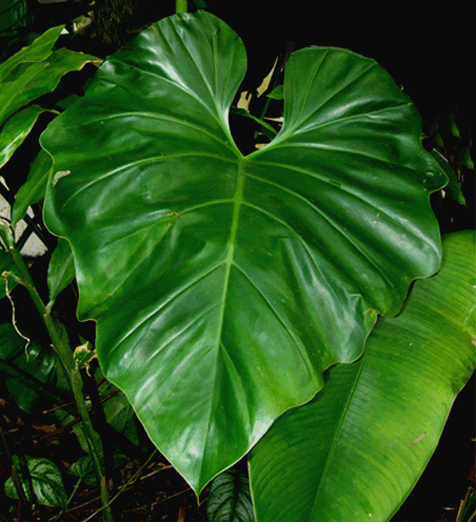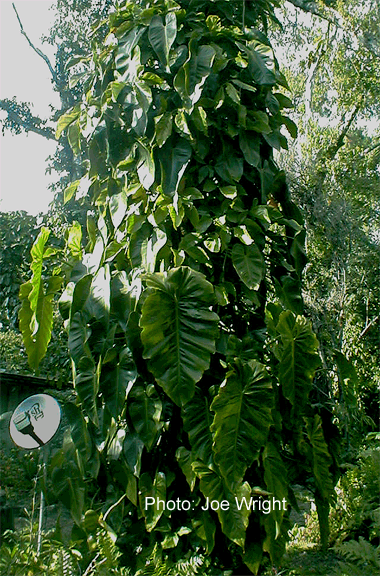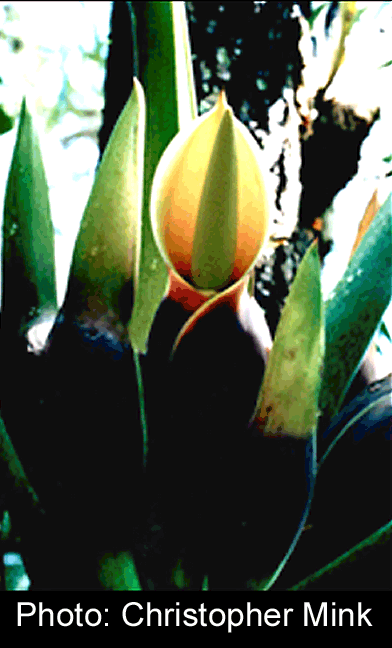![]()
Aroids and other genera in the Collection
Take the Tour Now?
Orchids
The
Exotic Rainforest
Plants in
the Exotic Rainforest Collection
The images on this website are copyright protected. Please contact us before any reuse.
In depth information on
how to grow Philodendron
species, Click this Link
Within our collection we have many species of Philodendron. If you are seeking other photos, click this link:
Philodendron subincisum
Schott

Philodendron subincisum Schott
Often incorrectly known
as
Philodendron wilsonii
Philodendron wilsonii
Philodendron subincisum is a
beautiful climber that grows big, really big! In the summer of 2006 a collector asked if he could a cutting
of my Philodendron wilsonii. I'm
obsessed with knowing the correct botanical name of my plants and enjoy
researching details
of the plants I collect and grow. I had known this plant
as Philodendron wilsonii for years, but had never bothered to look it up
in a botanical journal. I decided it was time I finally look this one up
just to be sure of its history. The name Philodendron wilsonii did not show up in
any scientific data base! It could not be found on
TROPICOS or IPNI (The International Plant Names Index). Nor could it be found in any botanical journal
or text in my library. I
was stunned!
The name Philodendron wilsonii was all
over the internet. Many sites, including some you would expect to
have done their homework had it listed by that name, and they italicized
it just as if it was a scientific name. It isn't! Had I been using the wrong name for this plant for years?
Were all the other collectors I know who have the same species
 using the
wrong name? It was time to find out!
using the
wrong name? It was time to find out!
 using the
wrong name? It was time to find out!
using the
wrong name? It was time to find out!
I sent a photo of my plant to Dr. Tom Croat of the Missouri
Botanical Garden. Dr. Croat is recognized as the leading authority
in Philodendron and Anthurium species in North America. Dr. Croat came back and asked for a detailed close-up
of the petiole. He then responded saying the correct botanical name
for the species is Philodendron
subincisum, and
there is no such plant as P. wilsonii!
Philodendron
subincisum has a very glossy leaf that grows on an approximately 2 inch (5cm)
stem (cane).
The inset photo which was furnished by Fort Myers, FL grower Joe Wright,
shows how large the plant can grow once it catches and climbs any tree
(look at the satellite dish for a size comparison). Joe says this
Philodendron was an "escapee" from his nearby greenhouse and just took off once
it caught the tree. As I said, this Philodendron gets big! All you need do to start a new plant
is cut off the top of a cane with enough air root and stick it in the soil.
In addition to Joe's photo I have seen
this species in Miami climbing well up into the branches of very large trees.
Philodendron subincisum loves shade but will tolerate bright indirect
light. Give it lots of water and well draining soil. But
remember, according to all the databases and Dr. Croat, this plant is not
Philodendron wilsonii. That name is said by Dr. Croat to have originated
from the late Bob Wilson, owner of Fantastic Gardens, then passed around
as the horticultural name.
The correct name for the species is
Philodendron subincisum, and the
plant is endemic to Mexico.
Philodendron subincisum is found near Veracruz in the
Poza
Rica region at elevations of less than 1,600 feet (500 meters). According
to the plant's technical scientific description, "Philodendron
subincisum is apparently rare having been collected only once".
In South Florida it is hardly
"rare". According to a personal email from
Dr. Croat the species was originally collected by botanist George Bunting in
Mexico and cultivated at Cornell. Bunting had many friends in the Miami
area and apparently gave away cuttings to people in the area, one of which
was the parent of my plant.
 All Philodendron
species are aroids.
An aroid is a plant that reproduces by producing an
inflorescence known to science as a spathe and
spadix. The spadix is a spike on a thickened
fleshy axis which can produce tiny flowers. Most people believe the spathe is a
"flower", it is not. The spathe is simply a
specially modified
leaf
appearing to be a hood
whose purpose is to protect the spadix at the
center. On the spadix at the center of
the inflorescence there can be found very tiny
flowers when the plant is at anthesis. When ready to
reproduce, the spadix produces male, female and
sterile flowers which if pollinated by an
appropriate insect, normally a beetle, will
produce berries containing seeds.
All Philodendron
species are aroids.
An aroid is a plant that reproduces by producing an
inflorescence known to science as a spathe and
spadix. The spadix is a spike on a thickened
fleshy axis which can produce tiny flowers. Most people believe the spathe is a
"flower", it is not. The spathe is simply a
specially modified
leaf
appearing to be a hood
whose purpose is to protect the spadix at the
center. On the spadix at the center of
the inflorescence there can be found very tiny
flowers when the plant is at anthesis. When ready to
reproduce, the spadix produces male, female and
sterile flowers which if pollinated by an
appropriate insect, normally a beetle, will
produce berries containing seeds.
The story of how
this species came into the Exotic Rainforest collection is somewhat
interesting. Janice and I
used to drive all over South Florida to find new plants. One of the
busiest drives in the southern part of Miami is SW 116th St. Not a lot of
plant sellers on that street but we had seen a sign with "plants for sale"
on the side of the road many times near where one of our daughters went to
high school. We never stopped. One morning the sign had changed. It
read "Must Sell Everything ". We stopped.
The lady's old broken
down home had been sold by court to a builder who was going to build
million dollar homes on her prime real estate. Her yard wasn't
landscaped, but it was filled with large Philodendron, Monstera,
Heliconia and other plant species. They all had to be dug up or meet the fate
of a bulldozer! I've always had a soft spot for large leaf Philodendron sp.
and she had a bed filled with one she called Philodendron wilsonii that
also were climbing her trees. Each leaf was close to 3 feet (90cm)! She
almost shouted, "dig it yourself, $20." Well, that's not "", like
her sign said, but I had never seen the plant for sale so out came a $20 dollar
bill and off came my coat! I can't count how many new plants we have
grown from that start in the years since. At one time we had 6 or
7 large plant groups in our yard in Miami all grown for that single $20
plant.
Philodendron species,
and especially hybrid forms, are
known to be highly variable and not every leaf of every specimen
will always appear the same. This link explains in
non-technical language natural variation and
morphogenesis within aroids and other.
Click
here.
Want to learn more
about aroids?
Join the International Aroid Society: http://www.exoticrainforest.com/Join%20IAS.html
Join the International Aroid Society: http://www.exoticrainforest.com/Join%20IAS.html